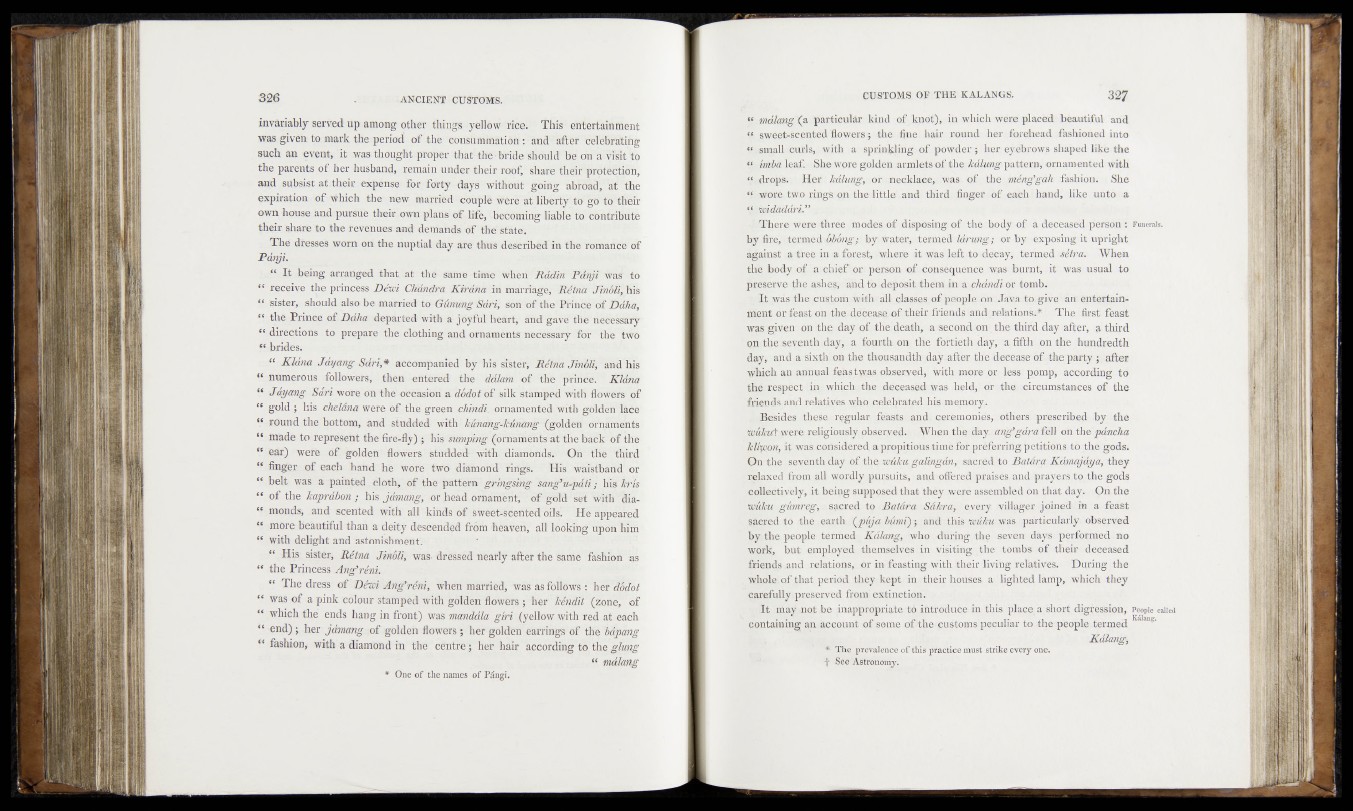
invariably served up among other things yellow rice. This ' entertainment
was given to mark the period of the öonSümrMtión : and after celebrating
such an event,, it was1 thought proper -thatkife-bride stio'uld be én a-visit to
the parents of her husband, remain under their roof, share their "protection,
and subsist at.their expense for forty days without going abroad, at the
expiration of rihich the new married-couplé were at liberty to gïj“ttiftÉîeir
own house and pursue their own plans of life, '-becoming liable‘to contribute
their share to the revenues and demands Of thé state.
The dresses worn on the nuptial day are thus1 described"in the romance of
Pdnji.
IAf‘ It being arranged that at the same time when Rddin ' F'ànjî sd&è to
“ receive the princess Démi CJùkidrà Kirdna in marriage; Rétna JtnbW, hrs
« sister, should also be married" to Gunung Sari, SoiTof the Prihce df Ddha,
** jfjSÈ Tflnoé Défia departed with a jbyfol heart, and gaVeJ"tKfe"néè?eS,^aiy'
“ directions to prepare the clothing and omamèntsneéégskfÿ fóf - £tie1 two
“ brides.
::c“ Kidna Jayang Sari,* accompanied’by his Sister,- Rétn'd Jiiîbli, and "liis
“ numerous followers, then entered the ddlam of ;the 'prin&e; KUnd
“ ffóyang Séri wore on the occasion a dbdot of -silk stamped with flôWèils^df
“ gold ; his chelâna were of the green chindi, ornamentëd-with^gmâèn^làcô
“ round the bottom, and studded with hünangfcdnangA^goldéti Ornements
“ made to represent the tire-fly) $ his sumping (^ornarfehte'-at the back bf*the
“ ear) werfe df golden flowers studded-with diamOfids'.V ■ '/third
“ finger. ef cad* -hand he wore two diamond rings. wais&aon or:
“ belt was a painted cloth, of the pattern ■ grmgsihg Hdng’u-pdti ; Wtl1cris
“ of the kaprdbon ; Ms jdmang,’ -or head ornament; - dfrgöïd "¥èt "^ithJelia-
“ monds, .and scented with all kinds of sweet-scented ôilâ?" disappeared
“ mbre beautiful than a deity descended from Heaven, all looking' Updn hirh
“ with delight and astonishment-.
. ssstêrv Rétna Jinêli,- was--dressed nearly after the'sâmé' fashion as
“ the Princess Ang’réni.
“ The dress o f^Démi ■Aiïg’rétn, when married, was as follows : h^aoçlot
“ was ©f a pink colour stamped with golden flowers j '-h’er" 'hêndü^ÇÉonë,^ Of
“ which thé ends hang in front) was manddla giri (yellow with red attach
“ end) j . her jdmang :of golden flowers ; her golden earrings of thei>^pâng
“ fashion, with a diamond in the céntre ; her hair according to. the.gfvng
, 1, mdlang
One of the names of Pângi.
“ mdlmg (a iparticular kind of knot), in which were placed beautiful and
M sweet-scented flowers; the fine hair round her forehead fashioned into
“ . small curls, with a sprinkling of powder ; her eyebrows shaped like the
“ imba leaf. She wore gulden armlets of the ,kdlimg. pattern, ornamented with
“ «drops. Her Mfe®^,..oririiecklaee, i/w-as of the m.eng'gah ..fashion. She
“ wore two rings op the'.little'-, and third. finger of e&bhfhand, like unto a
‘^•Jmdadcmf’ „. j
-1.'There were three modes of disposing of the.tody of a deceased person t Funerals,
by qtenned Mbbmgj j by. watery ■ termed Id rim g :or by. exposing it upright
against ^ tree in a forest,. wherfe it wasleft dodefeayj., termed setrdr. When
the tody ..o£'a:ehief'or. person Bfieopsequence w.as burnt, rit was usual to
preserve the ashe§,-:and to’deposit them .in &;xhdndi or- tomb; j
v- dfjwaS xthe eus,tjOm .with all elasse.sof people <m_Jav-a,..to-give an entertainment
©Effeast'oh the. decease, ofitteir.friends»and')retoions#hi'Tto first feast
was given on-the day of the death, a iseeond e®/ tto'-thifd day after, a-third
Qn the seventh.day,. a fourths©® the fortieth-day,- a; fifth Ion the hundredth
day, and a sixth on the thousandth d ay lifter tfa^ftseea^e p fth e party j. after
which an annual feas t was. pbserved, with more.an less" pomp, according to
the respect in.: which the deceased was helqjj' ojr the .circumstances of the
friends and relatives who celebrated his .memory.
, «Besides theses, regular feasts andr cerhnionies, ..others, prescribed .by the
Wukuf were religiously pbser,ved.v When th© day.;ary&gdra fell on the pdneha
Miimon, it was considered a propitious.time for pr^femrig peri^i®118- to .the,gods«
On the,'Seventh day lof./the muku galingdn, sacrpdjftd Batdra Kdmajdya, they
relaxed from all wordly pursuits, and - offered i praises nnd/p,ra.y exs ,‘to the gods
collectively, .it being supposed that they wepe assembled on that day. On the
'muku -gumreg,^. sacred to Batdra Safer a, kgsegm villager joined»; in a feast
Sjiered to the earth (,puja bumfyi and .this muku was ^akti&ulady. observed
byjtfae. people termed ^ Kdlang, wlm tduring the 1 seven)id^ysriperformed Lno
work, but employed themselves:in; visiting ^he tombsl-sf-'their deceased
friends ,and relations, or in feasting with iheir- IhyihgirislatiVeg. paring the
wholelof that period they kept in .their houses- a-lighted lamp, which they
Carefully preserved fcOrri extinction’;’’ ; "
- - It may not be inappropriate to introduce in this place, a short digression, People called
containing an account of same of the customs peculiar to the people termed Kalaag’
: Kdlang,
* Ttgipjevalence 01'this^inictice must strike ey'£^-d®S1' ^
f- See Astronomy.